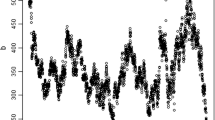Abstract
In this paper the Viennese stock exchange data are analysed by using ARMA and GARCH technology. After using AIC and BIC for estimating the linear structure of the time series, to the resulting innovations a GARCH(1,1) model is fit. The resulting residuals are then tested for serial independence and constancy of its distribution to check whether the models are reasonable. Main result is that the residuals of this ARMA-GARCH(1,1)-model are reasonably iid (which is checked by BDS and classical independence tests) for index data and significantly less well-behaved for stock data. Second, there is considerable autocorrelation in the data (especially in the Viennese indices WBK and ATX) which can be exploited even with 1.25% transaction costs (which is checked by a posteriori analysis of a strategy which exploits an underlying time-varying AR(1) model), however, much higher profit can be made with 0.5% transaction costs. Furthermore, the same techniques are applied to US Standard & Poor 500 index and the results for both data sets are compared giving the result that the US-market looks much more “mature” than the Viennese one.
Similar content being viewed by others
References
Bollerslev T, Chou RY, Kroner KF (1992) ARCH modelling in finance; A review of the theory and empirical evidence. Journal of Econometrics 52, 1/2:5–60
Brock WA, Dechert WD, Scheinkmann JA and LeBaron B (1988) A test for independence based on the correlation dimension. Technical Report, University of Wisconsin, Madison WI
Brock WA, Hsieh DA, LeBaron B (1991) Nonlinear dynamics, chaos and instability. MIT Press, Cambridge
Dockner EJ, Elsner J, Geyer A, Prskawetz A (1993) Deterministic chaos versus stochastic modelling in the analysis of Austrian financial series. Working paper
Engle R (1982) Autoregressive conditional heteroscedasticity with estimates of the United Kingdom inflation. Econometrica 50/4:987–1007
Engle R, Bollerslev T (1986) Modelling the persistence of conditional variances. Econometric Reviews 5/1:1–50
Geyer A (1992) ARCH and co-integrated models of the Viennese stock market. Draft
Kunst RM (1993) Fourth moment structures in financial time series. IAS Vienna Research Memorandum 335
Kunst RM, Reschenhofer E, Rodler K (1991) Analysis of Austrian stocks: Testing for stability and randomness. Empirical Economics 16:465–477
Reitgruber W, Sterlina I (1994) Short term forecasting and trading strategies for the Viennese stock market, mimeo Institute for Econometrics, Operations Research and System Theory, University of Technology, Vienna, Research Report 135
Skaug HJ, Tjostheim D (1993): Nonparametric tests of serial independence, 1993, to appear in Priestley Birthday Volume
Author information
Authors and Affiliations
Additional information
Financial Support by the Institute for Advanced Studies, Vienna, and the “Fonds zur Förderung der wissenschaftlichen Forschung”, Vienna, Grant P 9176 is gratefully acknowledged. This paper is a slightly abbreviated version of the Research Report No. 135 by the same authors (see References), which contains many detailed plots of the results.
Rights and permissions
About this article
Cite this article
Reitgruber, W., Sterlina, I. On the forecastability of share prices on the Viennese stock exchange. Empirical Economics 20, 415–433 (1995). https://doi.org/10.1007/BF01180674
Received:
Revised:
Issue Date:
DOI: https://doi.org/10.1007/BF01180674




